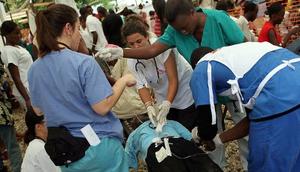Haiti's cholera crisisCholera treatment centers set up in Haiti's capital
Port-au-Prince is estimated to be home to between 2.5 million and 3 million people, about half of whom have been living in homeless encampments since the 12 January earthquake ravaged the capital; Port-au-Prince’s pre-earthquake sanitation and drinking water systems were already miserable owing to neglect and indifference by successive Haitian governments, and health experts say that these conditions make the city “ripe for the rapid spread of cholera”

Cholera treatment centers set up across Port-au-Prince // Source: tehrantimes.com
Doctors and aid groups are rushing to set up cholera treatment centers across Haiti’s capital as officials warn that the disease’s encroachment into the overcrowded city will bring a surge in cases.
Hundreds of people were already suspected of having cholera, suffering the disease’s symptoms of fever and diarrhea while lying in hospital beds or inside shacks lining the putrid waste canals of Cite Soleil, Martissant and other slums. “We expect transmission to be extensive and we have to be prepared for it, there’s no question,” Dr. Jon K. Andrus, deputy director of the Pan-American Health Organization (PAHO), told reporters Tuesday. “We have to prepare for a large upsurge in numbers of cases and be prepared with supplies and human resources and everything that goes into a rapid response.”
Yahoo! News reports that following Monday’s confirmation that a 3-year-old boy from a tent camp near Cite Soleil had contracted cholera before 31 October without leaving the capital, the organization said the epidemic’s spread from river towns in the countryside to the nation’s primary urban center was a dangerous development.
Two more capital-originated cases were confirmed Tuesday at the same hospital where the boy was treated.
Physicians with the aid group Doctors Without Borders reported seeing more than 200 city residents with severe symptoms at their facilities alone over the last three days.
More than 70 other cholera cases had been confirmed among people living in Port-au-Prince, but those became infected while outside the capital.
Damage to Port-au-Prince’s already miserable pre-earthquake sanitation and drinking water systems make the city “ripe for the rapid spread of cholera,” Andrus said.
Port-au-Prince is estimated to be home to between 2.5 million and 3 million people, about half of whom have been living in homeless encampments since the 12 January earthquake ravaged the capital.
A confirmed case of cholera had never been seen in this Caribbean country before last month, when it suddenly killed several dozen people and spread across the agricultural heartland of the Artibonite Valley. The U.S. Centers for Disease Control and Prevention found that the strain is most similar to those found in South Asia, but no formal investigations have been done to learn how the disease arrived in Haiti.
It has killed more than 580 people and hospitalized more than 9,500, with confirmed cases across the entire northern two-thirds of the country. Dozens of cases are rumored throughout the south.
On Tuesday, Haiti’s health ministry said the disease has become a threat to the entire nation of ten million people.
“Now it is our duty as citizens to help solve this problem, which has gone from being an urgent humanitarian matter and gone to the level of national security,” the ministry’s executive director, Dr. Gabriel Timothee, said during a televised news conference.
The disease, primarily spread when infected fecal matter contaminates food or water, is treatable, mainly by rehydrating the sick with safe water mixed essentially with salt, sugar and potassium or with intravenous fluids. Antibiotics also are used sometimes.
Yahoo! News reports that decades of failing and often regressing infrastructure — wracked by political upheaval, unbalanced foreign trade, a 1990s embargo and natural disasters — have left millions of Haitians without access to clean water, sanitation, or medical care.
Haitian and foreign aid workers continued campaigns to tell people to wash their hands, cook food thoroughly and take other precautions against the spread of cholera.
Health officials said that cholera will be part of the Haitian landscape for a long time, taking its place among the other challenges in one of the world’s most difficult places to live.
“We have to think about and plan for the long term,” Andrus said. “The bacteria have a foothold in the rivers and the water system, so it will be there for a number of years.”
